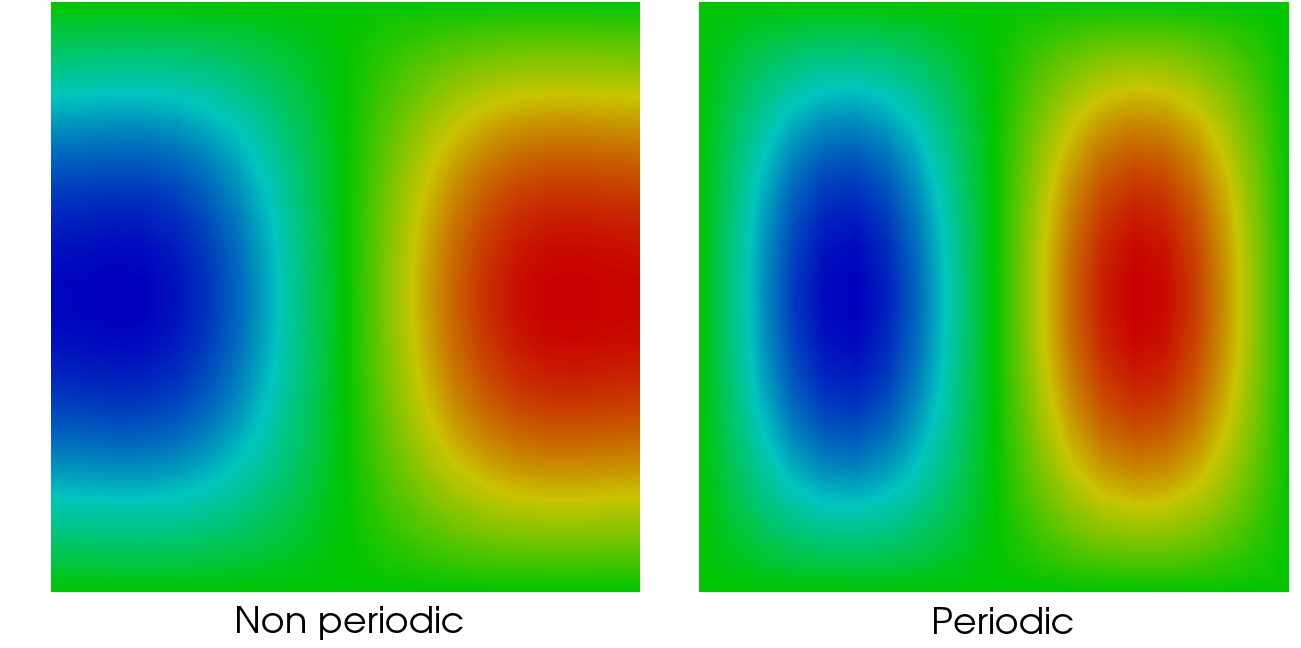2D Laplace problem with periodic condition#
Now we consider the Laplace problem on the unit square \(\Omega=]0,1[\times ]0,1[\) equipped with Dirichlet condition on and periodic condition:
\[\begin{split}\begin{cases}
-\Delta u = f & \mathrm{\;in\;}\Omega \\
u_{|\Gamma^-}=0 \mathrm{\;and\;} u_{|\Gamma^+}=0 & \\
u_{|\Sigma^-}=u_{|\Sigma^+} \mathrm{\;and\;} \partial_xu_{|\Sigma^-}=\partial_xu_{|\Sigma^+} &
\end{cases}\end{split}\]
and its variational formulation in \(V=\{v\in H^1(\Omega),\ u_{|\Gamma}=0 \mathrm{\;and\;} u_{|\Sigma^-}=u_{|\Sigma^+}\}\):
\[\begin{split}\left|\begin{array}{c}
\mathrm{find\;}u\in V \mathrm{\;such\;that\;} \\
\displaystyle \int_\Omega \nabla u.\nabla v=\int_\Omega f\,v \quad \forall v\in V.
\end{array}
\right.\end{split}\]
Its approximation by \(P^2\) Lagrange finite element is implemented in XLiFE++ as follows:
#include "xlife++.h"
using namespace xlifepp;
Real f(const Point& P, Parameters& pa = defaultParameters)
{
Real x=P(1), y=P(2);
return (4*pi_*pi_*y*(y-1)-2)*sin(2*pi_*x);
}
Vector<Real> mapPM(const Point& P, Parameters& pa = defaultParameters)
{
Vector<Real> Q(P);
Q(1)-=1;
return Q;
}
int main(int argc, char** argv)
{
init(argc, argv, _lang=en); // mandatory initialization of xlifepp
// mesh square
Strings sn("y=0", "x=1", "y=1", "x=0");
SquareGeo sq(_origin=Point(0., 0.), _length=1, _nnodes=20, _domain_name="Omega", _side_names=sn);
Mesh mesh2d(sq, _shape=triangle, _generator=structured);
Domain omega=mesh2d.domain("Omega");
Domain sigmaM=mesh2d.domain("x=0"), sigmaP=mesh2d.domain("x=1");
Domain gammaM=mesh2d.domain("y=0"), gammaP=mesh2d.domain("y=1");
defineMap(sigmaP, sigmaM, mapPM); // useful to periodic condition
// create P2 Lagrange interpolation
Space V(_domain=omega, _interpolation=P2, _name="V");
Unknown u(V, _name="u");
TestFunction v(u, _name="v");
// create bilinear form and linear form
BilinearForm auv=intg(omega, grad(u)|grad(v));
LinearForm fv=intg(omega, f*v);
EssentialConditions ecs = (u|gammaM = 0) & (u|gammaP = 0)
& ((u|sigmaP) - (u|sigmaM) = 0); // EssentialConditions ecs
TermMatrix A(auv, ecs, _name="A");
TermVector B(fv, _name="B");
// solve linear system AX=F using factorization
TermVector U=directSolve(A, B);
saveToFile("U_LP", U, _format=vtu);
// Solving eigen problem intg(omega, grad(u)|grad(v))=lambda intg(omega, u*v) with ecs
BilinearForm uv=intg(omega, u*v);
TermMatrix Ae(auv, ecs, _reduction=ReductionMethod(_pseudoReduction, 0., 1000.), _name="Ae");
TermMatrix Me(uv, ecs, _reduction=ReductionMethod(_pseudoReduction, 0., 1.), _name="Me");
EigenElements eigs=eigenSolve(Ae, Me, _nev=10, _which="SM");
Complex l1=eigs.value(1); // first eigen value
TermVector e1=eigs.vector(1); // first eigen vector, "eliminated" components are not up to date
e1.applyEssentialConditions(ecs); // update "eliminated" components of e1
eigs.applyEssentialConditions(ecs);// update "eliminated" components of all eigen vectors
return 0;
}
Note that at corners, periodic condition and Dirichlet condition are redundant. When executing, the following warning message is thrown
Constraints::reduceConstraints() : in essential conditions
Dirichlet condition u = 0 on y=0
Dirichlet condition u = 0 on y=1
periodic condition u|x=1 - u|x=0 = 0
2 redundant constraint row(s) detected and eliminated

Fig. 15 Solution of the Laplace 2D problem with periodic condition on the unit square \([0,1]^2\)#
